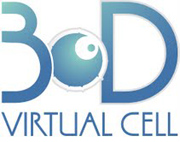Toward the 3D Virtual Cell Conference
November 26, 2012
 The 3D Virtual Cell could do for cell biology what the Large Hadron Collider has done for particle physics. But instead of building a multi-billion-dollar facility, backers of the 3D Virtual Cell project believe they can build a virtual, rather than physical, resource that could be used by biologists and medical researchers for generations to come.
The 3D Virtual Cell could do for cell biology what the Large Hadron Collider has done for particle physics. But instead of building a multi-billion-dollar facility, backers of the 3D Virtual Cell project believe they can build a virtual, rather than physical, resource that could be used by biologists and medical researchers for generations to come.
With support from the National Science Foundation (NSF), the University of California, San Diego will launch a year-long series of workshops, beginning with “Toward the 3D Virtual Cell,” a conference set to take place Dec. 13-14, 2012, at the California Institute for Telecommunications and Information Technology (Calit2) on the UC San Diego campus.
“Many of the top names in cell biology and cyberinfrastructure will join us to explore critical areas and challenges facing anyone who attempts to build a resource of this magnitude,” said Phil Bourne, principal investigator on the NSF grant and a professor of the UCSD Skaggs School of Pharmacy and Pharmacology. “Cell biology occurs at many scales, and a resource for modeling and visualization must operate on an increasingly large, diverse, complex and widely-distributed body of digital biological data.”
The 3D Virtual Cell, as envisaged, would provide the scientific framework to collect and disseminate software associated with all aspects of molecular and cellular biology in a way that can be understood by practicing scientists. To explore this field, conference attendees will be asked to address the grand challenges facing whole-cell modeling, and what computational, sociological or other obstacles must be overcome in order to the resource.
“You can think of it as a giant app store of freely-available, open-source software, data, educational materials and expertise that would become the go-to resource for researchers in the life sciences, no matter what biological scale they are working at,” said UC San Diego’s Bourne.
The conference is open to university researchers as well as scientists from other La Jolla institutions that focus on research in the life sciences. These would include the Salk Institute for Biological Studies, Sanford Burnham Medical Research Institute, The Scripps Research Institute, La Jolla Institute for Allergy & Immunology, as well as their joint stem-cell research center with UC San Diego, the Sanford Consortium for Regenerative Medicine.
Several of these institutions are represented among the nearly 40 speakers on the conference agenda, with international speakers coming from as far afield as New Zealand and Germany. For more on the confirmed speakers and the topics of their presentations, visit http://itsb.ucsd.edu/conference-toward-3d-virtual-cell-speakers.
Organizers hope conference participants will coalesce around a set of scientific challenges, while identifying existing tools for cellular modeling. Said Bourne: “We also aim to begin defining the types of algorithms, software paradigms, workflow development and visualization tools that will be needed to overcome challenges related to data accessibility, software re-use and sustainability.”
NSF provided funding for a series of six workshops over the next year. The ultimate goal: to create the “conceptual design” for a new Institute for Translational Systems Biology (ITSB) at UC San Diego. It would emphasize biological, 3D structures from molecules to cells, and address the challenge of how to perpetuate the 3D Virtual Cell resource going forward. ITSB would be part of NSF’s Software Infrastructure for Sustained Innovation (S2I2) program, which focuses on the establishment of long-term hubs of excellence in software infrastructure and technologies that will serve a research community of substantial size and disciplinary breadth.
Among the areas highlighted for discussion at the inaugural workshop on Thursday, December 13: whole cell modeling, network pathway modeling, and visualization. The following day, talks will continue on whole cell modeling, followed by a session on structure-based modeling, and parallel sessions devoted to analysis, as well as education and dissemination. Other topics to be explored will include: neurological modeling; ontologies and tools for modeling; modeling “big data”; and software engineering workflows for modeling.
There is limited seating for this event. Please reserve your place herehttp://itsb.ucsd.edu/conference-toward-3d-virtual-cell-registration. For further details, contact Stephanie Hagstrom at 858-534-1219 or [email protected].